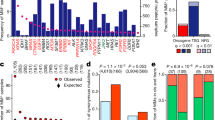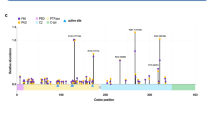Abstract
The seminal ‘two-hit hypothesis’ implicitly assumes that bi-allelic tumour suppressor gene (TSG) mutations cause loss of protein function. All subsequent events in that tumour therefore take place on an essentially null background for that TSG protein. We have shown that the two-hit model requires modification for the APC TSG, because mutant APC proteins probably retain some function and the two hits are co-selected to produce an optimal level of Wnt activation. We wondered whether the optimal Wnt level might change during tumour progression, leading to selection for more than two hits at the APC locus. Comprehensive screening of a panel of colorectal cancer (CRC) cell lines and primary CRCs showed that some had indeed acquired third hits at APC. These third hits were mostly copy number gains or deletions, but could be protein-truncating mutations. Third hits were significantly less common when the second hit at APC had arisen by copy-neutral loss of heterozygosity. Both polyploid and near-diploid CRCs had third hits, and the third hits did not simply arise as a result of acquiring a polyploid karyotype. The third hits affected mRNA and protein levels, with potential functional consequences for Wnt signalling and tumour growth. Although some third hits were probably secondary to genomic instability, others did appear specifically to target APC. Whilst it is generally believed that tumours develop and progress through stepwise accumulation of mutations in different functional pathways, it also seems that repeated targeting of the same pathway and/or gene is selected in some cancers.
This is a preview of subscription content, access via your institution
Access options
Subscribe to this journal
Receive 50 print issues and online access
$259.00 per year
only $5.18 per issue
Buy this article
- Purchase on Springer Link
- Instant access to full article PDF
Prices may be subject to local taxes which are calculated during checkout




Similar content being viewed by others
References
Albuquerque C, Breukel C, van der Luijt R, Fidalgo P, Lage P, Slors FJ et al. (2002). The ‘just-right’ signaling model: APC somatic mutations are selected based on a specific level of activation of the beta-catenin signaling cascade. Hum Mol Genet 11: 1549–1560.
Fiegler H, Carr P, Douglas EJ, Burford DC, Hunt S, Scott CE et al. (2003). DNA microarrays for comparative genomic hybridization based on DOP-PCR amplification of BAC and PAC clones. Genes Chromosomes Cancer 36: 361–374.
Fodde R, Smits R . (2001). Disease model: familial adenomatous polyposis. Trends Mol Med 7: 369–373.
Gaasenbeek M, Howarth K, Rowan AJ, Gorman PA, Jones A, Chaplin T et al. (2006). Combined array-comparative genomic hybridization and single-nucleotide polymorphism-loss of heterozygosity analysis reveals complex changes and multiple forms of chromosomal instability in colorectal cancers. Cancer Res 66: 3471–3479.
Hanahan D, Weinberg RA . (2000). The hallmarks of cancer. Cell 100: 57–70.
Jones AM, Thirlwell C, Howarth KM, Graham T, Chambers W, Segditsas S et al. (2007). Analysis of copy number changes suggests chromosomal instability in a minority of large colorectal adenomas. J Pathol 213: 249–256.
Knudson AG . (2001). Two genetic hits (more or less) to cancer. Nat Rev Cancer 1: 157–162.
Lamlum H, Ilyas M, Rowan A, Clark S, Johnson V, Bell J et al. (1999). The type of somatic mutation at APC in familial adenomatous polyposis is determined by the site of the germline mutation: a new facet to Knudson's ‘two-hit’ hypothesis. Nat Med 5: 1071–1075.
Leslie A, Stewart A, Baty DU, Mechan D, McGreavey L, Smith G et al. (2006). Chromosomal changes in colorectal adenomas: relationship to gene mutations and potential for clinical utility. Genes Chromosomes Cancer 45: 126–135.
Michor F, Iwasa Y, Vogelstein B, Lengauer C, Nowak MA . (2005). Can chromosomal instability initiate tumorigenesis? Semin Cancer Biol 15: 43–49.
Schneikert J, Grohmann A, Behrens J . (2007). Truncated APC regulates the transcriptional activity of beta-catenin in a cell cycle dependent manner. Hum Mol Genet 16: 199–209.
Sieber OM, Heinimann K, Gorman P, Lamlum H, Crabtree M, Simpson CA et al. (2002). Analysis of chromosomal instability in human colorectal adenomas with two mutational hits at APC. Proc Natl Acad Sci USA 99: 16910–16915.
Sieber OM, Segditsas S, Knudsen AL, Zhang J, Luz J, Rowan AJ et al. (2006). Disease severity and genetic pathways in attenuated familial adenomatous polyposis vary greatly but depend on the site of the germline mutation. Gut 55: 1440–1448.
Sieber OM, Tomlinson SR, Tomlinson IPM . (2005). Tissue, cell and stage specificity of (epi)mutations in cancers. Nat Rev Cancer 5: 649–655.
Spirio LN, Samowitz W, Robertson J, Robertson M, Burt RW, Leppert M et al. (1998). Alleles of APC modulate the frequency and classes of mutations that lead to colon polyps. Nat Genet 20: 385–388.
Su LK, Barnes CJ, Yao W, Qi Y, Lynch PM, Steinbach G . (2000). Inactivation of germline mutant APC alleles by attenuated somatic mutations: a molecular genetic mechanism for attenuated familial adenomatous polyposis. Am J Hum Genet 67: 582–590.
Wood LD, Parsons DW, Jones S, Lin J, Sjoblom T, Leary RJ et al. (2007). The genomic landscapes of human breast and colorectal cancers. Science 318: 1108–1113.
Acknowledgements
We are grateful to colleagues at St Mark's Hospital for tissue collection, to several kind providers of cell lines and to the Mutation Detection Facility, Cancer Research UK London Research Institute.
Author information
Authors and Affiliations
Corresponding author
Rights and permissions
About this article
Cite this article
Segditsas, S., Rowan, A., Howarth, K. et al. APC and the three-hit hypothesis. Oncogene 28, 146–155 (2009). https://doi.org/10.1038/onc.2008.361
Received:
Revised:
Accepted:
Published:
Issue Date:
DOI: https://doi.org/10.1038/onc.2008.361
Keywords
This article is cited by
-
Copy number of the Adenomatous Polyposis Coli gene is not always neutral in sporadic colorectal cancers with loss of heterozygosity for the gene
BMC Cancer (2016)
-
DDX3 promotes tumor invasion in colorectal cancer via the CK1ε/Dvl2 axis
Scientific Reports (2016)
-
The mini-driver model of polygenic cancer evolution
Nature Reviews Cancer (2015)
-
Insertional mutagenesis identifies multiple networks of cooperating genes driving intestinal tumorigenesis
Nature Genetics (2011)
-
β-Catenin pathway activation in breast cancer is associated with triple-negative phenotype but not with CTNNB1 mutation
Modern Pathology (2011)



